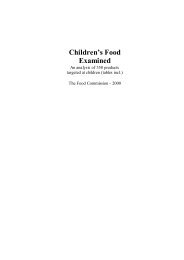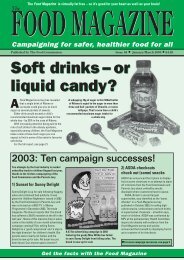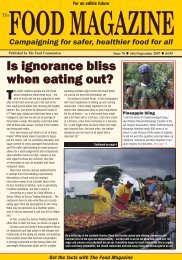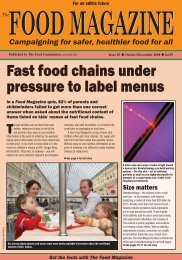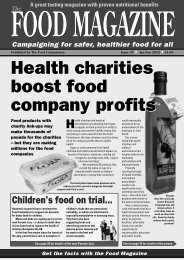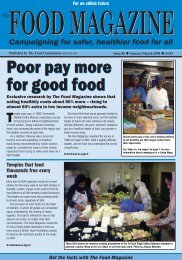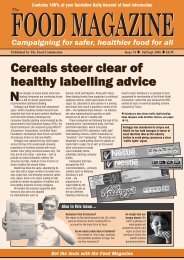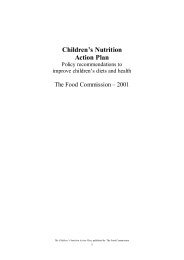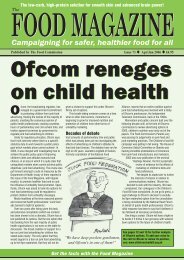Food Magazine - The Food Commission
Food Magazine - The Food Commission
Food Magazine - The Food Commission
You also want an ePaper? Increase the reach of your titles
YUMPU automatically turns print PDFs into web optimized ePapers that Google loves.
nutrition<br />
But it couldn’t happen<br />
here, surely<br />
It's not just US dietary advice that is prone to being adapted<br />
according to the politics and concerns of the day. We took<br />
a dip into our archive to show readers some versions of<br />
the UK’s ‘Balance of good health’ that have appeared<br />
over the years.<br />
Avisual representation of the healthy<br />
‘balance’ of foods is a useful tool for<br />
communicating nutritional messages<br />
about a whole diet. It avoids complicating the<br />
story with discussion of individual nutrients. It<br />
also helps nutrition advisors to show people how<br />
individual foods can fit into the overall balance.<br />
Pictures have great power to express the<br />
importance of certain food groups. <strong>The</strong> official<br />
‘balance of good health’ shows the important<br />
role of complex carbohydrates, fruit and<br />
vegetables, which visually dominate the plate.<br />
However, companies and trade bodies also<br />
understand the power of an image. That’s why<br />
they design their own subtly-altered versions, to<br />
shift the emphasis to their own products.<br />
Eat more meat!<br />
We rather enjoyed this image from a<br />
2001 Meat & Livestock <strong>Commission</strong><br />
leaflet. It is one of the few representations<br />
of the 'Balance of good health' that removes<br />
the small 8% portion (foods containing fat<br />
and foods containing sugar) – placing it right<br />
outside the circle.<br />
<strong>The</strong> foods inside the circle are essential. <strong>The</strong><br />
foods outside may be tasty, but they are additional<br />
and not necessary for a healthy diet.<br />
Of course, that also means there is extra room<br />
for the meat and dairy sections conveniently to<br />
expand by a few degrees…<br />
<strong>The</strong> ‘meaty’ version<br />
Eat more potatoes!<br />
We receive all sorts of industry information that<br />
tries to skew the standard message to show<br />
particular food products in a favourable light.<br />
This plate leaflet (below) from the British<br />
Potato Council (2005) is a fairly mild example. In<br />
the carbohydrates section of the plate (33 per<br />
cent) there is not a sign of wholegrain foods –<br />
one slice of white bread and a pile of cornflakes.<br />
<strong>The</strong> rest is dominated by… guess what Boiled<br />
and mashed potatoes!<br />
Eat more sugar!<br />
A favourite example (this one from further back<br />
in our archive – it was first circulated in 1998)<br />
shows that the manufacturer thought that 50<br />
per cent of your diet should be carbohydrate –<br />
making no distinction between the complex<br />
starchy carbohydrates in bread and potatoes<br />
(which we should eat more of) and the simple<br />
sugary carbohydrates in confectionery (of<br />
which we should eat less).<br />
Funnily enough, this was sent to us by a<br />
confectionery company – Mars (now<br />
Masterfoods). So much for balance!<br />
<strong>The</strong> ‘Mars’ version



